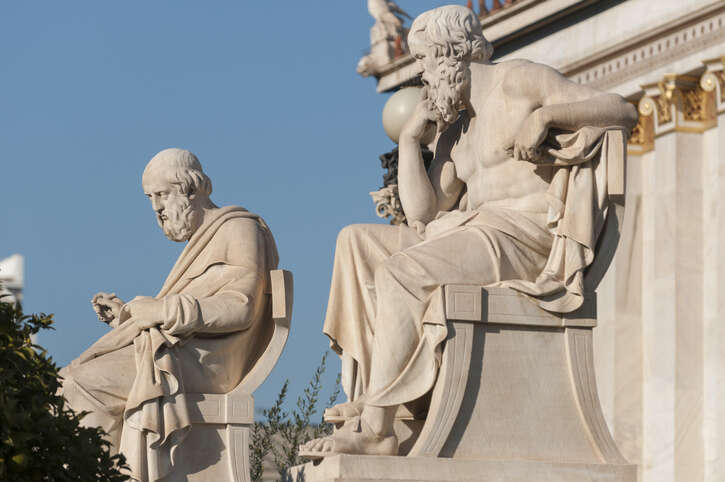
This is a bottle I don’t want to open. It’s not, though, a wine “for keeping,” and in any case I don’t have storage space just now—so I’m going to uncork it, on this bright spring afternoon, just a few months after it was bottled.
Why reluctant? Perhaps I’ll never have the chance to taste this wine again; perhaps, in a few years, the wine won’t exist. Yet the vineyards from which it comes were cleared and terraced a millennium ago. They’re wedged between sea and sky, and tended with muscle alone. They represent agriculture at its most daring; their remnants (for that is all that is left) have won a place in the cultural catalogs with which humans attempt to defy the destructive power of time. This wine is on sale in the little cooperative shop at Groppo di Riomaggiore for €16, yet it’s worth more, in terms of accumulated human experience and winemaking struggle, than any bottle of Lafite or Pétrus.
You’ll know of Cinque Terre, I’m sure—a small, 10-mile (15km) stretch of the Ligurian coastline between the naval port of La Spezia and the little sea town of Levanto. Steep hills lift 1,600ft (500m) into the sky, sheer from the sea; there are few beaches and no natural ports. A spot like this in New Zealand or southern Chile would be considered impossible to cultivate and uninhabitable for all earthly time. Not so in the medieval Republic of Genoa. Once the coastline had been cleansed of Saracen pirates by ships flying the Genoese Cross of St George, farmers and fishermen arrived, initially from the sheltered foothold of Monterosso al Mare. They looked upward and somehow saw a living beckon there. What they left behind are the physical remnants of past human energy: tottering, pastel-painted village houses mortared on to bare rock, and 1,400ha (3,460 acres) of walled terraces that soar upward and outward from them like green-feathered wings from a bird’s slight body, linked by the fragile bones of countless hewn steps.
Bosco’s last stand
The work of human hands made this landscape, and without the continuing work of human hands, nature will take it back. The process is well advanced. In the 1950s, the only route into Cinque Terre was to walk over the mountains, step off a bobbing boat, or alight from the train that threads the bottom of the cliffs. Some 500ha (1,235 acres) of terraces were still cultivated back then, when there were few economic alternatives for the villagers other than smallholding. The roads that arrived in the 1960s made the Cinque Terre wine grower’s life fatally easier—by bringing mass tourism.
The grower became a chef or a hotel electrician or a gift-shop owner; he or she no longer had to climb 300 steps every morning to get to work, in all weathers, and walk down them to get home again, and carry baskets of grapes wearyingly up and down in the heat of harvest. The process of abandon began to speed then, and it hasn’t slowed since; only 80ha (200 acres) of cultivated terraces now remain, and the grapes arrive in cardboard boxes or shopping baskets. “Our job,” says Matteo Bonanini, part-time president of this cooperative of part-timers, “is to stop the abandonment. No one wants to sell their land, but no one wants to work it, either. Many of our members are over 80. Every time one dies, another 300m [1,000ft] are lost.”
Tree heather was traditionally planted as a windbreak in the acid sandstone soils of Cinque Terre, and I was there as its soft white flowers seethed at the plant fringes, like decorative hoar frost. I looked around, through the misty spring air; the heather seems to be eating up the terraces, bite by bite, with jubilant exuberance, rendering the hills greener and greener. The bare patches on the hills were where vines grew. Those patches were sparse, especially in the most distant or inaccessible plots—a strange grimace of soil here, a wry lip of brown land there. You could imagine the time- lapse photographs to come, showing the pieces of heather slowly filling up the jigsaw.
There’s another reason to lament the process, too: Bosco. This ancient Genoese variety is the core of every Cinque Terre white, and the only variety used for the fine, gentle, tannic local passito called Sciacchetrà (made with extensive skin contact). It’s used in combination with Vermentino for the dry wines and, together with the salt sea breeze, accounts for much of the print of the place when you meet the wines themselves. It’s little grown elsewhere. This is Bosco’s last stand.
The Cinque Terre cooperative produces three wines from subzones on the hillside, of which this wine is one, from the Manarola area. Costa da’ Posa comes from Volastra, and Costa de Sèra from Riomaggiore. I would, I think, be happy drinking this wine as my staple white for the rest of my life. It’s pale gold, and light in scent: fresh leaves, fresh almonds or hazels. It’s light on the tongue and easy on the stomach, too, but supremely graceful, with a marrowy core and with markedly saline edges that work with its soft, understated acidity to give the wine remarkable focus and precision. Grape, apple, pear, and quince, with a little cucumber for luck, wrapped up in a seashell—delicious. How can we lose this? But if we are to keep it, who will do the work?




